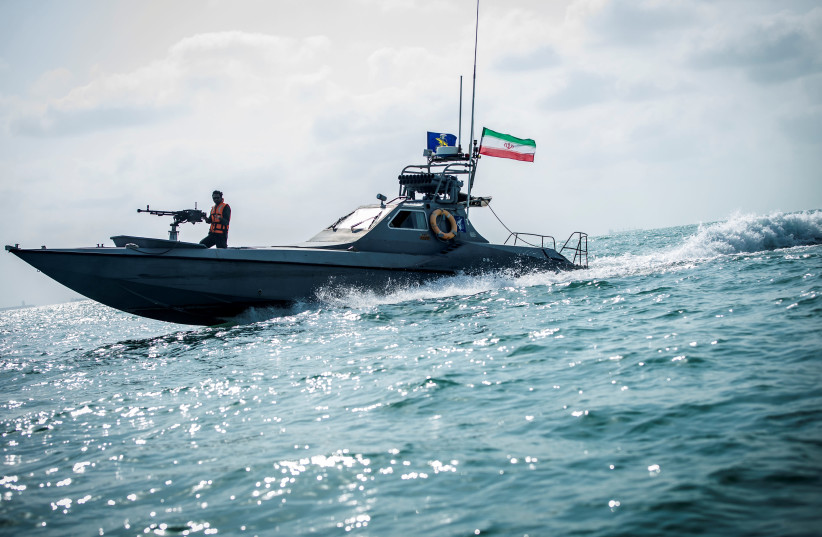Iran’s goal is to keep these groups armed and ready to support its activities, such that they can be operationalized or used as leverage and tools for Tehran’s regional project.
SETH J. FRANTZMAN
AUGUST 4, 2021 19:31

Iran’s latest move, days after it used drones to attack a ship off the coast of Oman, was apparently an attempt to send men to board and hijack a ship.
This isn’t the first time: Iranian agents were also responsible for doing something similar in July 2020 when the Gulf Sky disappeared off the coast of Oman and ended up off the coast of Iran in mysterious circumstances.
Yesterday it was the Asphalt Princess that appeared to be targeted for piracy by Iran. Reports early on Wednesday implied the ship had been released; the full details are not clear.
What is clear is that Iran’s goal is to spread chaos using unpredictable behavior. This policy applies not just in the areas around the Gulf, but throughout the Middle East.
cnxps.cmd.push(function () { cnxps({ playerId: ’36af7c51-0caf-4741-9824-2c941fc6c17b’ }).render(‘4c4d856e0e6f4e3d808bbc1715e132f6’); });
Iran operates through a series of proxies and partners, from Yemen to Iraq, Syria and Lebanon. These groups have varying degrees of links to Iran, some of them are likely directly controlled by the Islamic Revolutionary Guard Corps. Others, like Hamas, are supported by Iran but probably do not take orders from Tehran.
Iran’s goal is to keep these groups armed and ready to support its activities, such that they can be operationalized or used as leverage and tools for Tehran’s regional project. This means that the Houthis in Yemen, fighting Saudi-backed Yemeni government forces, have been “put on steroids” by the Islamic Republic, armed with drones and ballistic missiles.
Iran provides know-how to help these groups build longer-range missiles. Hamas, for instance, increased the range of its rockets from several kilometers in the early 2000s to more than 250 km. in 2021.
THE HIJACKING of the Asphalt Princess and then its apparent release may be one example of sowing chaos. Regardless of the overall details about these incidents, the sense that there is a threat hanging over the Gulf is part of the overall strategy of Iran. It is why Iran uses small IRGC fast boats to harass US naval ships in the Persian Gulf. And it is why Iran has used drones to fly over US aircraft carriers in the past.
The goal is to show that Iran has the opportunity, if it wants, to strike where it wants. This leaves regional countries that want trade and stability to wonder whether escalation is in their interest. Iran’s goal is not to defeat all these countries, but merely to increase the potential price that might be paid if there is a conflict. The mining of ships in May and June of 2019 was an example, as was the attack on Abqaiq in Saudi Arabia in September 2019, and other incidents over the last six months, such as several attacks on commercial ships.
The concept of “unpredictable Iran,” which often acts more like a mafia state than a normal country, is a policy choice. It is the same way Tehran uses pressure in the Vienna talks and nuclear negotiations. It boasts about uranium enrichment, regardless of whether it actually wants to detonate a nuclear device one day. It knows that the prospect of Iran acquiring nuclear weapons is enough to bring other countries to the table. No other state in the world ever used nuclear threshold status as a negotiating tactic.
Iran has become an expert at this kind of nuclear blackmail, and now at its ship piracy threat. For example, Tehran tried to stop the British Heritage tanker in July 2019. It also grabbed the British-flagged Stena Impero tanker when one of Iran’s tankers was interdicted by British forces off Spain. The Stena Impero was eventually released in September 2019.
These are games Iran is good at – and so far it has worked wonders for Tehran. In the past, Iran has also used kidnapping, hostage-taking and even detaining foreign sailors as a means to get what it wants and embarrass other countries, such as the US or UK.
This is calculated unpredictability, to make it appear that even though Iran has a weak navy, it can spread chaos across a thousand miles of open ocean and the Persian Gulf.
Content retrieved from: https://www.jpost.com/middle-east/iran-news/irans-threat-in-gulf-is-to-be-unpredictable-analysis-675827.